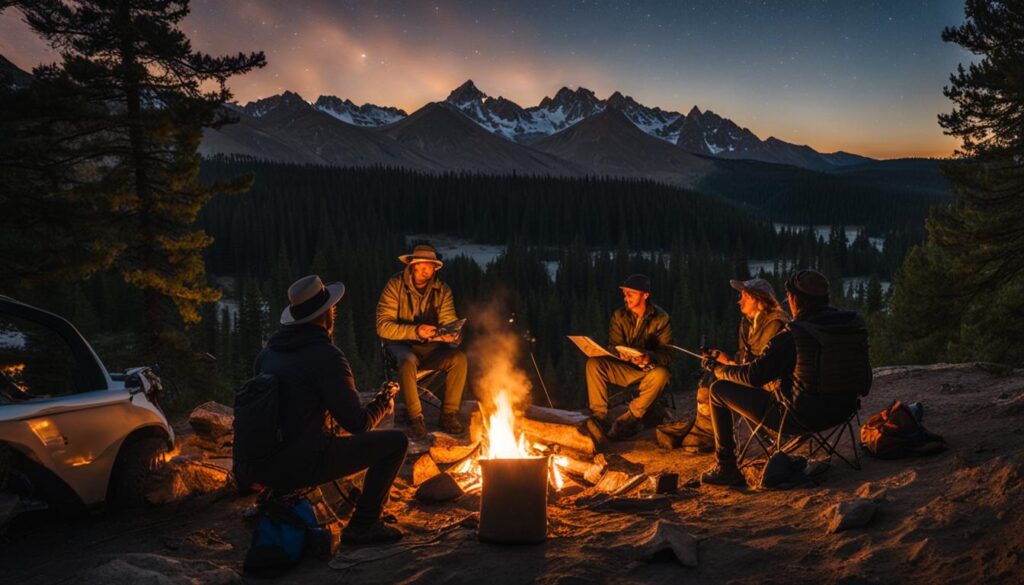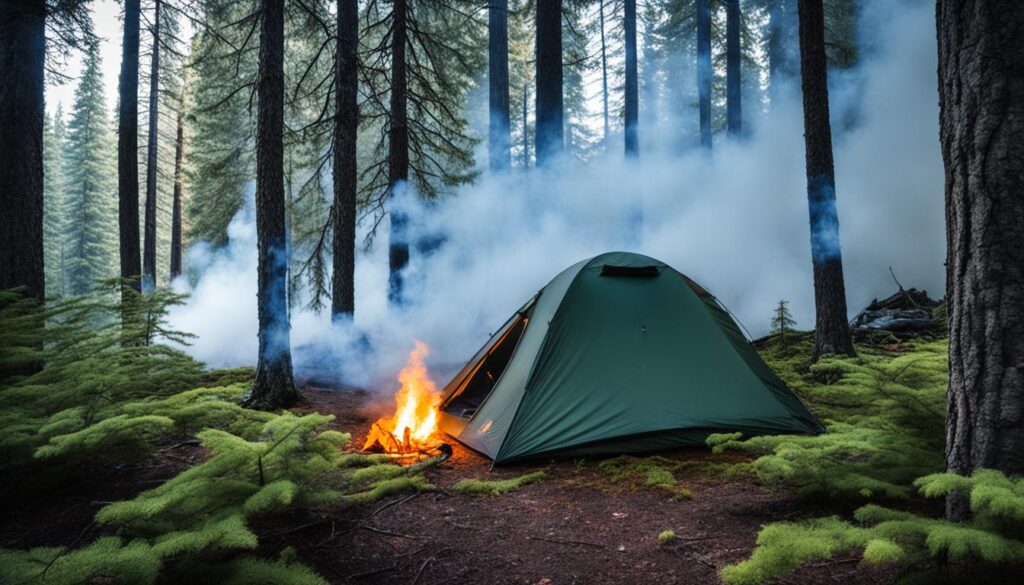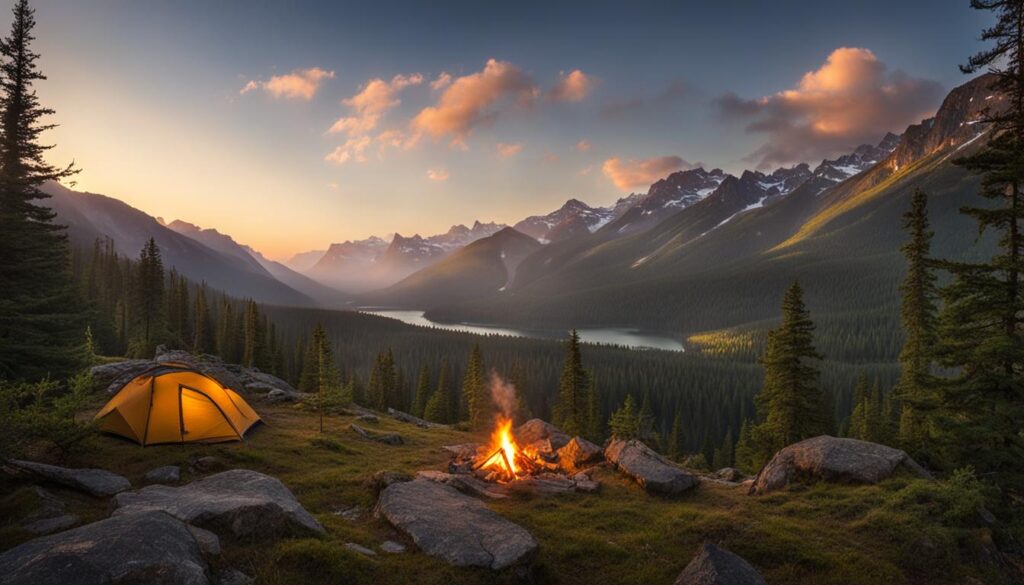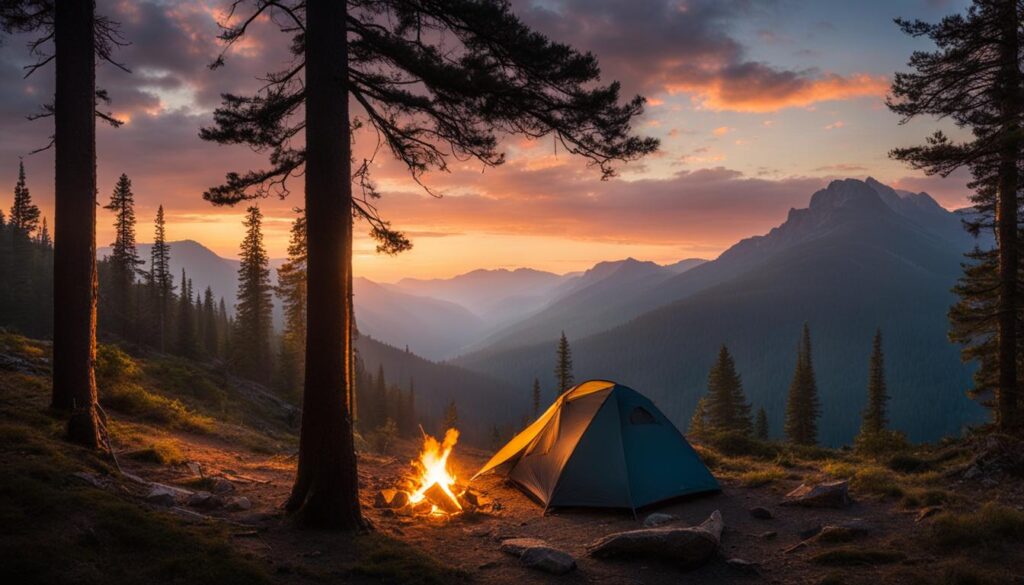Are you ready to leave behind the comforts of modern camping and immerse yourself in the raw beauty of the wilderness? If so, boondock camping is the perfect adventure for you. Boondock camping, also known as off-grid or primitive camping, involves venturing into undeveloped and remote campsites without any hookups.
So, what is boondock camping exactly? Boondock camping refers to camping without relying on external amenities like electricity, water, and sewer connections. Instead, you rely on your own resources, making it a self-sufficient and off-grid experience. It’s about embracing the freedom and simplicity of camping in untouched natural settings.
The popularity of boondock camping has skyrocketed in recent years. With the closure of many campgrounds, the increasing overcrowding at established sites, and the desire for a more immersive camping experience, boondocking offers a refreshing alternative. It allows you to disconnect from the chaos of everyday life and reconnect with nature on a deeper level.
Key Takeaways:
- Boondock camping involves camping without hookups at undeveloped, remote campsites.
- It’s a self-sufficient and off-grid camping experience.
- Boondocking offers freedom, simplicity, and a closer connection with nature.
- It has gained popularity due to campground closures and overcrowding at established campsites.
- Boondock camping allows you to embrace the wild and experience a more immersive outdoor adventure.
Contents
What is Boondocking?
Boondocking is the ultimate adventure for off-grid camping enthusiasts. It allows you to disconnect from the hustle and bustle of everyday life and immerse yourself in the beauty of untouched nature. When you go boondocking, you leave behind the comforts of established campgrounds and embark on a journey to secluded and remote campsites.
Unlike traditional camping, boondocking does not rely on external electricity, water, and sewer connections provided by campgrounds. Instead, you become self-sufficient, utilizing your own onboard resources to power your adventure.

Whether you’re camping in an RV, camper van, or even a tent, boondocking gives you the freedom to choose your own unique camping experience. You can camp in serene forests, picturesque mountains, or along breathtaking coastlines.
When boondocking, you tap into your inner explorer. You venture off the beaten path, away from the crowds and amenities of established campgrounds, and find solace in the tranquility of nature.
Boondocking allows you to embrace a more sustainable and eco-friendly form of camping. By conserving resources and minimizing your environmental impact, you can fully appreciate the beauty and fragility of the natural world.
Get ready to embark on an unforgettable adventure as we dive deeper into the world of boondocking, exploring tips, hacks, and the best boondocking locations. Prepare to immerse yourself in the wonders of off-grid camping.
Advantages of Boondock Camping
Boondock camping, also known as dispersed camping, offers outdoor enthusiasts several advantages that make it an appealing option for those seeking a unique and budget-friendly camping experience.
1. Cost Savings
One of the major advantages of boondock camping is the opportunity to save money. Unlike staying at established campgrounds that often come with hefty fees, boondocking is often cheaper or even free. This makes it an ideal choice for campers on a budget.
2. Secluded and Quiet Camping Spots
Boondocking allows you to escape the crowds and noise typically found at busy campgrounds. Instead, you can find secluded areas in nature where you can enjoy peace and tranquility. These quiet camping spots offer a chance to disconnect from the hustle and bustle of daily life and fully immerse yourself in the beauty of the great outdoors.
3. Flexibility in Location and Duration
When boondock camping, you have more flexibility in terms of where and how long you can stay. Unlike established campgrounds that may have strict rules and regulations, boondocking allows you to camp in remote areas for extended periods. This freedom gives you the opportunity to explore and enjoy the wilderness at your own pace.
4. Self-Sufficiency and Resourcefulness
Boondock camping promotes self-sufficiency and resourcefulness. Without the amenities and services provided by established campgrounds, you need to rely on your own provisions and problem-solving skills. This encourages a sense of independence and resourcefulness as you navigate the challenges of off-grid camping.
Overall, boondock camping offers a unique and rewarding camping experience, providing opportunities for cost savings, solitude, flexibility, and the development of valuable self-sufficiency skills.
| Advantages of Boondock Camping |
|---|
| Cost Savings |
| Secluded and Quiet Camping Spots |
| Flexibility in Location and Duration |
| Self-Sufficiency and Resourcefulness |
Disadvantages of Boondock Camping
While boondock camping offers numerous advantages, such as the freedom to explore remote and untouched wilderness, there are several disadvantages to consider before embarking on your off-grid adventure.
One major challenge of boondock camping is the lack of amenities and services typically available at established campgrounds. Unlike traditional campsites, boondocking sites don’t provide access to essential facilities such as electricity, running water, or restroom facilities. This means you’ll need to rely on alternative methods to meet your basic needs and ensure your comfort.

Another disadvantage of boondocking is the need for extensive planning and preparation. As a self-sufficient camper, you’ll have to bring all the necessary supplies with you, including water, food, fuel, and other essentials. Careful consideration should be given to factors such as weather conditions, route planning, and the availability of resources in remote areas. Being adequately prepared ensures a safe and enjoyable boondock camping experience.
In addition, finding suitable camping spots for boondocking can require more effort compared to traditional campgrounds. If you’re seeking remote and secluded areas, you may need to spend time researching and exploring to discover the perfect spot. Stealth camping, where you discreetly camp in non-designated areas, can be an option but comes with heightened responsibility and respect for nature.
Remember, it’s crucial to research and follow local regulations regarding boondocking. Some areas may have restrictions or even prohibit boondock camping, so it’s essential to respect these rules and obtain any necessary permits. A wild camping guide can help you navigate the legal aspects of boondocking and find safe and permissible locations.
In summary, while boondock camping provides a unique and immersive camping experience, it comes with its share of challenges. The lack of amenities, the need for careful planning, and the effort required to find suitable camping spots can be considered as disadvantages. However, with proper preparation, responsible behavior, and adherence to local regulations, you can overcome these challenges and fully enjoy the freedom and beauty of boondock camping.
Where to Boondock?
If you’re looking for the best boondocking locations, you’re in luck. There are various places where you can enjoy the freedom and beauty of off-grid camping. Public lands managed by organizations like the United States Forest Service (USFS), National Park Service (NPS), U.S. Fish and Wildlife Service (FWS), and Bureau of Land Management (BLM) often allow boondocking or dispersed camping.
These public lands provide incredible opportunities to immerse yourself in remote and pristine natural settings. From towering forests to breathtaking deserts, you can choose from a wide range of landscapes to explore. Boondocking on public lands allows you to camp amidst the tranquility and serenity of untouched nature, far away from the hustle and bustle of crowded campgrounds.
In addition to federal public lands, some state-managed public lands also offer dispersed camping options. For example, California’s State Vehicular Recreation Areas (SVRAs) provide opportunities for boondock camping.
Before heading out to these locations, it’s essential to check with the relevant authorities and obtain any required permits. Familiarize yourself with the specific rules and regulations of the area to ensure a hassle-free experience.
Best Boondocking Locations
| Location | Features |
|---|---|
| 1. National Forests | Endless camping options, hiking trails, scenic vistas |
| 2. National Parks | Breathtaking landscapes, iconic attractions, wildlife viewing |
| 3. Bureau of Land Management Areas | Wide-open spaces, diverse ecosystems, stargazing opportunities |
| 4. Wildlife Refuges | Rich biodiversity, birdwatching, nature photography |
| 5. State Vehicular Recreation Areas | Off-roading trails, camping spots with recreational activities |
These are just a few examples of the best boondocking locations, each offering its own unique charm and natural wonders. Whether you’re seeking solitude in the wilderness or craving adventure in the great outdoors, these locations provide the perfect backdrop for your boondocking escapades.

Boondocking Essentials
When it comes to boondock camping, having the right essentials is crucial to ensure a comfortable and successful trip. Whether you’re hitting the road in your RV, off-road vehicle, or travel trailer, here are the must-have items that will enhance your boondocking adventure.
1. Reliable Vehicle and Basic Tools
A reliable vehicle, equipped with spare tires and basic tools, is essential for boondock camping. It will give you the confidence to explore remote locations and handle any minor repairs that may arise during your journey. Before setting off, make sure your vehicle is in good working condition and stock up on essential tools such as wrenches, screwdrivers, and tire repair kits.
2. Extra Supplies
Boondocking often means being away from amenities, so it’s important to bring extra supplies to sustain yourself. Consider bringing additional fuel, such as gasoline or diesel, to power your vehicle or generator. Pack extra propane for cooking and heating, and ensure you have enough water for drinking, cooking, and cleaning. Don’t forget to bring a way to filter and store water, ensuring you have access to clean water throughout your trip.
3. Camping and Cooking Supplies
When boondock camping, you’ll need basic camping supplies to create a comfortable living space. This includes a tent, sleeping bags, camping chairs, and a cooler to store food. Additionally, bring cooking supplies like a portable stove, pots, pans, and utensils to prepare meals. Consider packing easy-to-make meals and non-perishable food items to minimize waste and simplify meal preparations.
4. Emergency Kits
Safety should always be a priority during boondock camping. Be prepared for emergencies by packing first aid kits and emergency supplies. This can include items such as flashlights, batteries, a fire extinguisher, a GPS device, and a functioning communication device. It’s essential to have a plan in case of emergencies and to be aware of your surroundings at all times.
5. Navigation Tools
When exploring remote areas, reliable navigation tools are essential. Bring a detailed map of the area you’ll be camping in and consider a GPS device or a navigation app on your smartphone. It’s important to be familiar with the routes, trails, and surrounding landmarks to avoid getting lost and ensure safe travels.
| Boondocking Essentials Checklist |
|---|
| Reliable Vehicle and Basic Tools |
| Extra Supplies (Fuel, Propane, Water) |
| Camping and Cooking Supplies |
| Emergency Kits and Safety Gear |
| Navigation Tools (Map, GPS) |
By ensuring that you have these boondocking essentials, you’ll be well-prepared to embark on your off-grid camping expedition. Now that you have all the necessary items, it’s time to hit the road and experience the freedom and tranquility of boondock camping!
Boondocking Tips and Hacks
Are you ready to elevate your boondock camping experience? Here are some essential tips and clever hacks to make your adventure in the wild even more enjoyable.
First and foremost, start with shorter trips to familiarize yourself with boondocking before embarking on longer or more remote excursions. This will give you a chance to get accustomed to the unique challenges and rewards of camping off-grid.
Researching and planning your route ahead of time is crucial. Consider factors such as accessibility, available amenities, and local regulations. Having a well-thought-out plan ensures a smoother journey and helps you make the most of your boondocking adventure.
It’s always wise to have backup plans and alternative camping spots in mind. In popular boondocking areas, campsites can fill up quickly. Having a few backup options will ensure you’re never left without a place to park your RV or set up your tent.
Remember to practice Leave No Trace principles during your boondocking trips. Properly dispose of waste, respect the environment, and avoid disturbing wildlife. Leave the campsite as you found it, or even better, leave it cleaner than before. By minimizing our impact, we preserve the beauty of these wild spaces for future generations to enjoy.
Lastly, be prepared for limited or no cell service while boondocking. In remote areas, connectivity can be scarce. Have alternative communication methods like walkie-talkies or satellite phones to stay in touch with your fellow campers or in case of emergencies.
FAQ
What is boondock camping?
Boondock camping refers to camping without hookups at undeveloped, primitive, remote campsites. It is a form of off-grid camping where you rely on your own resources and self-sufficiency.
What are the advantages of boondock camping?
Boondocking offers several advantages, including being cheaper or even free compared to established campgrounds, finding secluded and quiet camping spots, having more flexibility in terms of location and duration, and promoting self-sufficiency and resourcefulness.
What are the disadvantages of boondock camping?
The main challenges of boondocking include the lack of amenities and services typically available at established campgrounds, the need for extensive planning and preparation, and the effort required to find suitable camping spots.
Where can I boondock?
Boondocking can be done in public lands managed by organizations like the United States Forest Service, National Park Service, U.S. Fish and Wildlife Service, and Bureau of Land Management. Some state-managed public lands also offer dispersed camping options.
What are the essentials for boondock camping?
Essentials for boondock camping include a reliable RV or travel trailer with spare tires and basic tools, extra supplies such as fuel, propane, and water, basic camping and cooking supplies, emergency kits, communication devices, and navigation tools.
Any tips for boondock camping?
Some tips and hacks for boondock camping include starting with shorter trips to get a feel for it, researching and planning your route ahead of time, practicing Leave No Trace principles, and being prepared for limited or no cell service.






